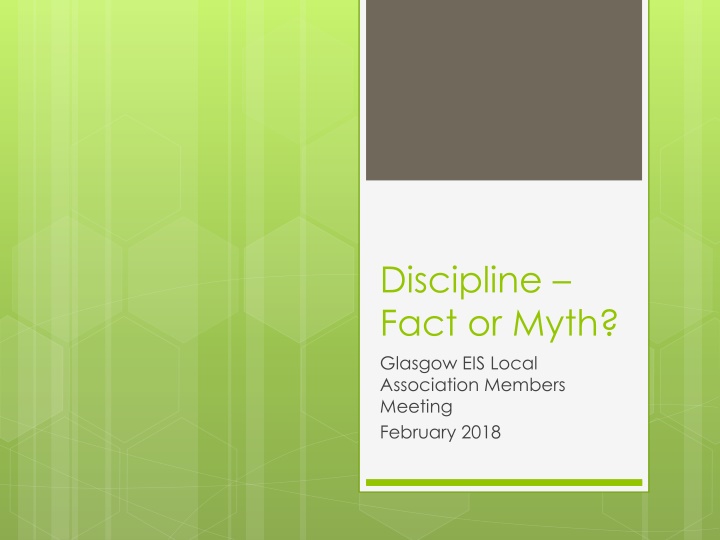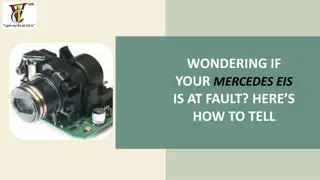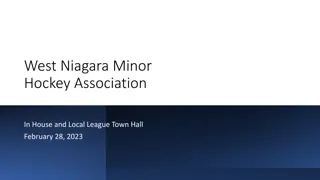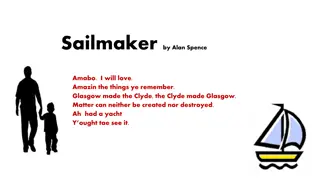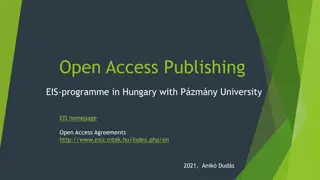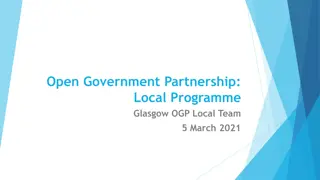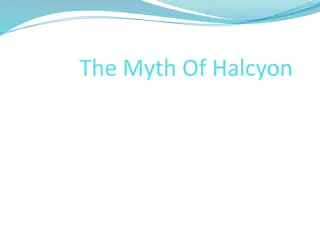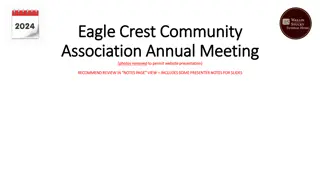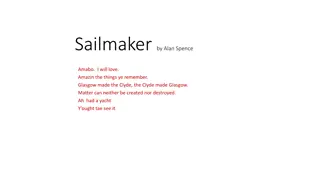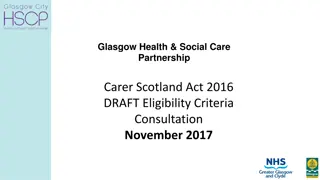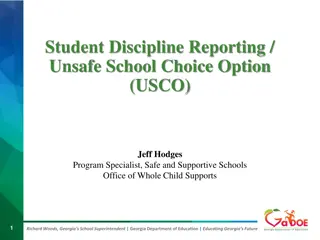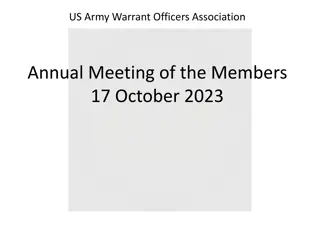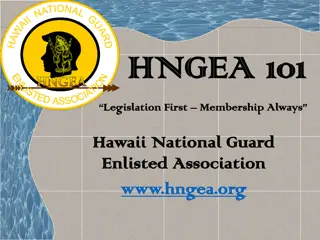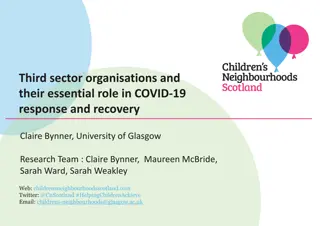Discipline: Fact or Myth in Glasgow EIS Local Association Members Meeting
Explore the myths and facts surrounding discipline practices in the Glasgow EIS Local Association meeting of February 2018. From the exclusion of pupils with Additional Support Needs to procedures for informal exclusions and incident reporting, learn about the guidelines and regulations set forth to ensure a fair and safe learning environment.
Download Presentation

Please find below an Image/Link to download the presentation.
The content on the website is provided AS IS for your information and personal use only. It may not be sold, licensed, or shared on other websites without obtaining consent from the author.If you encounter any issues during the download, it is possible that the publisher has removed the file from their server.
You are allowed to download the files provided on this website for personal or commercial use, subject to the condition that they are used lawfully. All files are the property of their respective owners.
The content on the website is provided AS IS for your information and personal use only. It may not be sold, licensed, or shared on other websites without obtaining consent from the author.
E N D
Presentation Transcript
Discipline Fact or Myth? Glasgow EIS Local Association Members Meeting February 2018
Fact or Myth? We can t exclude this pupil for anything because they have Additional Support Needs.
Myth Management Circular 8 states: The procedures outlined in this Management Circular apply equally to all schools and learning establishments in Glasgow City Council and must be complied with in full
Myth Wellbeing and Assessment Plan and Risk Assessment including the use of violence and weapons i. In any situation where a child or young person is identified or assessed as being at risk of exclusion, the current Risk Assessment and Wellbeing and Assessment Plan must be followed and reviewed appropriately; if neither of these assessments are already in place, they should be considered as part of the school s preventative strategy.
Myth 1.10 Informal Exclusions The practice of informal exclusions has no legal basis, is contrary to Glasgow City Council s Child Protection Procedures and should not be used in any circumstance. 1.11 Exceptional circumstance related to mental or emotional wellbeing i. Where it has identified that a child s or young person s additional support need pertains to significant mental or emotional distress, and/or a difficulty to self-regulate, the school may seek support from a parent/carer to help the child or young person de-escalate and to allow further planning to meet the needs of the child or young person at school level. This may, in some circumstances, involve the child or young person being taken home by the parent/carer in a similar way to a child or young person who presents as unwell. ii. While this is not an exclusion any intention to use this kind of supportive intervention must be: a) intimated to the Head of Service; b) for the shortest possible duration; c) identified in the child s or young person s Risk Assessment (see Section 4) and Wellbeing and Assessment Plan; d) reviewed and evaluated rigorously by the Learning Community - Joint Support Team or Staged Intervention and Inclusion Meeting (as appropriate).
Myth Procedures for Exclusion of any pupil is outlined within this document and should be clear within any school discipline policy. You can find the full document here: Management Circular 8
Fact or Myth? Only members of SMT can complete the Incident Reporting Form.
Myth The incident form is there to be used by anyone who is subject to an incident of violence or abuse. It can clearly be accessed from the Glasgow Online homepage and is found in top right corner. Staff should of course be discussing the incident with their Line Managers to ensure they have every opportunity to act upon what has happened to avoid any repeat. H&S consider these figures at their meetings.
Fact or Myth Pupils have the right to keep their mobile phone on in class.
Myth/Fact It depends on school policy EIS guidance document on misuse of mobile phones states Local Authorities and schools will have policies on mobile phones currently in place. Smartphones pose a problem for schools and it is important that extant policies are reviewed to cover guidelines/prohibitions on these phones.
Myth/Fact GCC policy in this area is: That each school should have their own policy based on common-sense. These policies should be made clear to all staff, pupils and parents to avoid conflict or confusion.
Fact or Myth? Teachers should not try to separate a fight between pupils.
Myth EIS policy is that where there is an immediate risk of harm to one or more a teacher can intervene. In terms of two pupils fighting there would appear a clear risk of harm to at least one of the two. Colleagues should be mindful of reasonable force.
Myth GCC have developing Guidelines and Procedures for use of Physical Intervention Physical Interventions Guidelines EIS policy in this area can be found here: Violent & Disruptive Pupils
Fact or Myth Teachers can refuse to teach pupils who are violent.
Myth A teacher s contract with an employer defines the employment law perspective. The contractual requirement is set out in the SNCT Handbook Part 2 paragraph 2.8, which states: 2.8 Subject to the policies and practice of the school and the Council, the duties of teachers are to: (a) manage and organise classes through planning and preparing for teaching and learning. 2.1.3A teacher who refuses to admit a persistently disruptive pupil would, in effect, be refusing to comply with her or his contractual terms. 2.1.4In terms of the employment contract the teacher who refuses to admit a disruptive pupil could be subject to disciplinary action.
Myth However: Councils do have a duty to protect the health and safety of their employees. Therefore, if a teacher could establish that, by admitting a disruptive pupil to class, her or his safety was at risk the teacher would have the potential right to refuse to admit the pupil and not be subject to disciplinary action. Councils also have a duty to protect the health and safety of other pupils in a class, and where there is a threat of physical violence, a risk assessment should be carried out and, based on its results, a case to refuse admittance may be made
Myth Where a pupil is violent staff should: Seek help from colleagues and management following establishment policy. The incident should be reported to management and the victim should ensure that the incident is recorded in the accident book and complete online incident reporting form
Myth Ensure a risk assessment is carried out and that strategies for de-escalation/support are clear to all involved Call police if they believe the violent incident against them to merit this action Management can assist by bringing police officers to the workplace to interview the victim and witnesses rather than putting the onus on the victim to report the matter to the Police at the end of the working day in their own time.
Fact or Myth If a pupil abuses me on Social Media it is okay for me to reply in kind as it s outside the school day.
Myth Teachers should not engage in any contact via Social Media with pupils. If there is abuse then it should be reported appropriately Social Media Guidance GTCS guidance on use of Social Media
Fact or Myth Every school should have a Discipline Policy which is regularly reviewed and shared with all new staff.
Fact GCC supports every establishment having a Promoting Positive Behaviour policy. This is backed up by GCC policy in this area, management of exclusions, anti- bullying policy and Management Circular on Violence in the workplace It would be good practice to review this annually and share with all new staff at start of term.
Fact/Myth Phoning the police will criminalise a young person and make life difficult for me in school/GCC.
Myth Phoning the police is part of your right as a citizen and indeed GCC include this in their flowcharts on how violent incidents should be dealt with Violence at Work Flow Charts
Myth Few young people will be charged as a result of assault on a staff member due to their age but it can be a support in getting them the additional support they require.
Fact Promoting Positive Behaviour Policy MC 8 Managing Exclusions Violence and Aggression to Staff MC 76 Anti-Bullying Policy Anti-Bullying Go Glasgow page PDF of Page EIS Policy and Guidance on Violence to Staff
